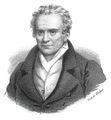Template:Selected anniversaries/May 9: Difference between revisions
Jump to navigation
Jump to search
No edit summary |
No edit summary |
||
| (5 intermediate revisions by the same user not shown) | |||
| Line 1: | Line 1: | ||
<gallery> | <gallery> | ||
File:Gaspard Monge.jpg|link=Gaspard Monge (nonfiction)|1746: Mathematician and engineer [[Gaspard Monge (nonfiction)|Gaspard Monge]] born. He will invent descriptive geometry, and do pioneering work in differential geometry. | File:Gaspard Monge.jpg|link=Gaspard Monge (nonfiction)|1746: Mathematician and engineer [[Gaspard Monge (nonfiction)|Gaspard Monge]] born. He will invent descriptive geometry, and do pioneering work in differential geometry. | ||
File:U-110.jpg|link=German submarine U-110 (1940) (nonfiction)|1941: The [[German submarine U-110 (1940) (nonfiction)|German submarine U-110]] is captured by the Royal Navy. On board is the latest Enigma machine which Allied cryptographers later use to break coded German messages. | File:U-110.jpg|link=German submarine U-110 (1940) (nonfiction)|1941: The [[German submarine U-110 (1940) (nonfiction)|German submarine U-110]] is captured by the Royal Navy. On board is the latest Enigma machine which Allied cryptographers later use to break coded German messages. | ||
File:West Ford needles and stamp.jpg|link=Project West Ford (nonfiction)|1963: [[Project West Ford (nonfiction)|Project West Ford]] launches, successfully deploying a ring of 480,000,000 copper needles in orbit, forming an artificial ionospheric radio communication system. | File:West Ford needles and stamp.jpg|link=Project West Ford (nonfiction)|1963: [[Project West Ford (nonfiction)|Project West Ford]] launches, successfully deploying a ring of 480,000,000 copper needles in orbit, forming an artificial ionospheric radio communication system. | ||
File:Nixon April-29-1974.jpg|link=Watergate scandal (nonfiction)|1972: [[Watergate scandal (nonfiction)]]: The United States House Committee on the Judiciary opens formal and public impeachment hearings against President Richard Nixon. | File:Nixon April-29-1974.jpg|link=Watergate scandal (nonfiction)|1972: [[Watergate scandal (nonfiction)]]: The United States House Committee on the Judiciary opens formal and public impeachment hearings against President Richard Nixon. | ||
</gallery> | |||
{{Template:Categories: May 9}} | |||
Latest revision as of 09:37, 7 May 2024
1746: Mathematician and engineer Gaspard Monge born. He will invent descriptive geometry, and do pioneering work in differential geometry.
1941: The German submarine U-110 is captured by the Royal Navy. On board is the latest Enigma machine which Allied cryptographers later use to break coded German messages.
1963: Project West Ford launches, successfully deploying a ring of 480,000,000 copper needles in orbit, forming an artificial ionospheric radio communication system.
1972: Watergate scandal (nonfiction): The United States House Committee on the Judiciary opens formal and public impeachment hearings against President Richard Nixon.



